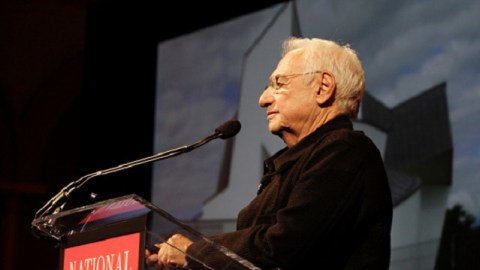What’s Behind Frank Gehry’s Raised Middle Finger to Contemporary Architecture?

Architect Frank Gehry’s raised many controversial buildings over the years, but few as controversial as the middle finger he recently raised during a press conference in Spain. During a press conference for Gehry’s upcoming receipt of the Prince of Asturias Prize from the hands of Spain’s King Felipe VI, a journalist touched a nerve when he asked if Gehry’s buildings were just about public relations-grabbing spectacle. Gehry glowered and raised the one-finger salute in response, a clear, if vulgar (and not necessarily international) sign of his displeasure with the pejorative title of “starchitect” he’s been saddled with over the years. Gehry’s gesture captured the headlines, but it was his response to the next question at that press conference where he really expressed his concern not over his reputation, but rather over the purpose of contemporary architecture itself.
A courageous journalist finally broke the long, awkward silence by asking Gehry if he thought that Gehry-esque “emblematic buildings” would continue to be built. Perhaps admiring how agilely the reporter danced around the “starchitect” word still hanging in the air, Gehry opened up: “Let me tell you one thing. In this world we are living in, 98% of everything that is built and designed today is pure shit. There’s no sense of design, no respect for humanity or for anything else. They are damn buildings and that’s it. Once in a while, however, a group of people do something special. Very few, but God, leave us alone. We are dedicated to our work. I don’t ask for work … I work with clients who respect the art of architecture. Therefore, please don’t ask questions as stupid as that one.”
It’s unclear whether Gehry’s stupid questions remark was aimed at the first, second, or both reporters, but it is clear that he sees a fundamental problem in contemporary architecture much bigger than him, his reputation, or his buildings. While many praise and pursue Gehry for “The Bilbao Effect”—the economic boom the faltering, former industrial city of Bilbao, Spain, enjoyed after the 1997 rise of architect Frank Gehry’s game-changing design for the Guggenheim Bilbao Museum—others criticize him for his unconventional designs that catch the eye but, they claim, fail to do much else. The Philadelphia Museum of Art recently staged an entire exhibition titled Making a Classic Modern: Frank Gehry’s Master Plan for the Philadelphia Museum of Art broadcasting their “master plan” for Gehry’s revitalization of their classic main building first opened in 1928 (which I wrote about here). Is Gehry really all sizzle and no steak for people hungry for meaningful architecture?
Gehry clearly believes he is making meaningful architecture. He contrasts his work against that with “no sense of design, no respect for humanity or for anything else.” For Gehry, a building is bad if “[t]hey are damn buildings and that’s it,” implying that other buildings (perhaps his) are more than just damn buildings. There’s a touch of un-starchitect humility in Gehry’s weary, “Once in a while, however, a group of people do something special. Very few, but God, leave us alone.” Gehry clearly includes himself in that happy few making “special” buildings, but also indirectly gives credit to those unnamed like minds that make up that humanist 2%.
I’d always struggled with finding meaning in modern architecture until I read Alain de Botton’s The Architecture of Happiness. de Botton’s signature combination of philosophy and psychology applied to architecture opened my eyes to how we live depends in part on where we live, work, play, and otherwise spend our time. Spending time in inspiring places can refresh the soul or challenge the mind. Conversely, as de Botton points out, the spare simplicity of a building such as Le Corbusier’s Villa Savoye might be the perfect tonic for a world looking for order in post-war chaos.
The question people should ask isn’t whether Gehry is a “good” architect (with all the messy disagreements that question involves), but rather whether he’s providing that tonic for what ails the modern human. You can question Gehry’s means, but there’s no questioning his end of making buildings that say something rather than nothing, which, for Gehry, is the true unpardonable sin of architecture and not unconventionally curving walls that aren’t to everyone’s taste.
After the combative press conference, Gehry apologized for his behavior and cited the effects of jet lag on his 85-year-old body. But Gehry has no need to apologize for his passion for designing buildings with the individual in mind. Gehry takes heat for how vigorously his leaves his stamp on his designs, but I see that powerful individualism not as grandstanding but rather as passionate communication. Here I am, Gehry says in his buildings, and here you are, too.
It’s no accident that Ayn Rand chose to make the hero of The Fountainhead an architect. Rand may take individualism too far, but that doesn’t dismiss the fact that architects literally leave their personalities on our landscape as few others can. “The Bilbao Effect” isn’t about the cold economics of profit as much as about heating up communities chilled by economic and social circumstances. Whether Gehry’s “98%” is an accurate estimate or a jet-lagged exaggeration, the fact remains that anything that sheds light and heat on how our environment influences us—even a rude gesture—deserves a hearty thumbs up.
[Image:Frank Gehry speaking in 2007. Image source.]




